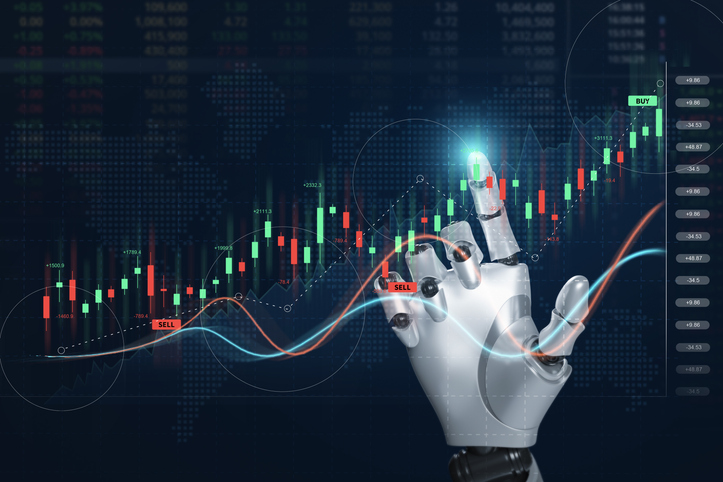The world of trading has always been about speed, precision, and strategy. From the early days of floor trading to the rise of algorithmic trading, technology has played a pivotal role in shaping financial markets. Today, in 2025, the next big leap is here: Artificial Intelligence (AI) in trading.
AI is not just a tool anymore — it’s becoming the core engine of modern trading strategies, capable of analyzing massive datasets, predicting trends, reducing risks, and even executing trades automatically. In this article, we’ll explore how AI is transforming trading, the key technologies behind it, and what the future holds for investors and traders.

Why AI is Important in Trading
Traditional trading strategies rely heavily on:
- Technical indicators (moving averages, RSI, MACD).
- Fundamental analysis (earnings reports, economic indicators).
- Human decision-making (trader psychology, experience).
While these methods are still valuable, they cannot process real-time global data streams at the scale required in today’s markets. AI, however, excels in:
- Processing massive datasets (news, social media, financial reports).
- Detecting patterns invisible to human traders.
- Making lightning-fast trading decisions.
- Reducing the impact of human bias and emotions.
This makes AI an indispensable tool for both institutional investors and retail traders.
Core AI Features Driving Trading in 2025
1. AI-Powered Algorithmic Trading
AI algorithms analyze real-time price movements, order books, and historical trends to execute trades within milliseconds. Unlike traditional algorithms, AI can adapt dynamically to market conditions.
✅ Benefit: Reduced latency and higher trade efficiency.
✅ Example: Hedge funds using reinforcement learning to optimize buy/sell strategies.
2. Predictive Market Analytics
AI models like LSTMs (Long Short-Term Memory) and Transformers forecast market trends using time-series data. These predictions allow traders to anticipate price fluctuations with higher accuracy.
✅ Benefit: Improved market forecasting.
✅ Example: AI predicting Bitcoin’s short-term price swings based on sentiment + technical data.
3. Sentiment Analysis for Trading
Markets are not only driven by numbers but also by news, social media, and public sentiment. AI-powered NLP (Natural Language Processing) systems analyze:
- Tweets
- Reddit discussions (like WallStreetBets)
- Financial news headlines
✅ Benefit: Traders can identify bullish or bearish sentiment before price movements occur.
✅ Example: Detecting a wave of positive news about Tesla before a stock rally.
4. Robo-Advisors for Investors
AI-driven robo-advisors provide personalized investment strategies by analyzing risk tolerance, income levels, and long-term goals.
✅ Benefit: Automated portfolio management for beginners and professionals alike.
✅ Example: AI managing ETF portfolios for passive investors.
5. Fraud Detection and Risk Management
AI identifies unusual trading behaviors and protects traders from fraud and market manipulation. By analyzing patterns across millions of trades, AI prevents flash crashes and pump-and-dump schemes.
✅ Benefit: Safer and more transparent trading environment.
✅ Example: AI systems flagging suspicious crypto transactions.
6. AI in High-Frequency Trading (HFT)
HFT firms use machine learning models to execute thousands of trades per second, capitalizing on tiny price inefficiencies.
✅ Benefit: Higher profits in microseconds.
✅ Example: AI trading bots that exploit arbitrage opportunities in forex or crypto.
AI in Different Trading Markets
1. Stock Trading
AI predicts stock price movements, automates strategies, and helps institutional traders outperform benchmarks.
2. Forex Trading
In currency markets, AI analyzes global macroeconomic factors and predicts volatility based on political events, central bank announcements, and sentiment data.
3. Crypto Trading
The crypto market is highly volatile. AI bots thrive here by:
- Detecting arbitrage opportunities.
- Predicting bull runs and crashes.
- Analyzing on-chain metrics.
4. Commodities and Futures
AI models predict oil, gold, and agricultural price trends by analyzing global supply-demand, weather conditions, and geopolitical tensions.
Advantages of AI in Trading
✅ Speed: Executes trades in milliseconds.
✅ Accuracy: Identifies profitable opportunities faster than humans.
✅ 24/7 Monitoring: Perfect for crypto and forex.
✅ Emotion-Free: Eliminates fear, greed, and bias.
✅ Scalability: Handles millions of data points at once.
Challenges and Risks
❌ Overfitting Models: AI may misinterpret data.
❌ Market Volatility: Black swan events can still surprise AI systems.
❌ Regulatory Concerns: AI-driven manipulation may raise compliance issues.
❌ Accessibility: Advanced AI tools are still dominated by big institutions.
The Future of AI in Trading
Looking ahead, AI will continue to:
- Integrate with blockchain: Ensuring transparent and secure trading.
- Use Quantum Computing: For ultra-fast market simulations.
- Enable Autonomous Trading Agents: Self-learning bots that outperform humans.
- Enhance Retail Trading Apps: Giving small traders Wall Street-level AI tools.
By 2030, AI-driven trading could account for over 80% of all global trades.

